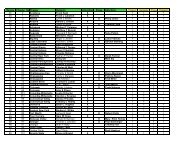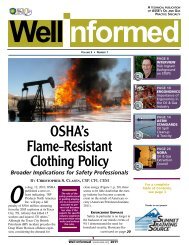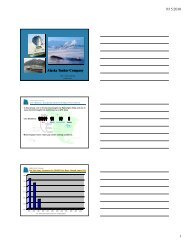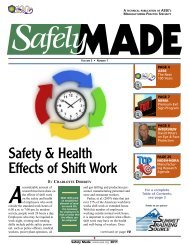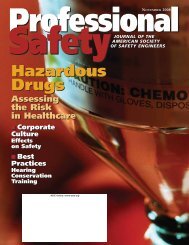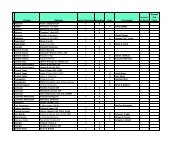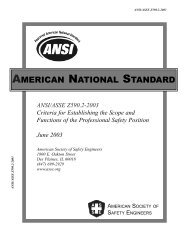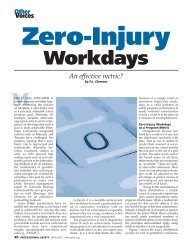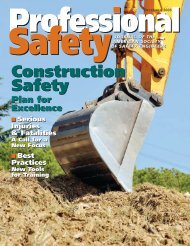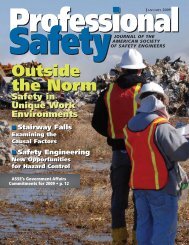Safety 2008 - ASSE - American Society of Safety Engineers
Safety 2008 - ASSE - American Society of Safety Engineers
Safety 2008 - ASSE - American Society of Safety Engineers
Create successful ePaper yourself
Turn your PDF publications into a flip-book with our unique Google optimized e-Paper software.
Rules &RegsHotlinks<strong>ASSE</strong><strong>American</strong> <strong>Society</strong><strong>of</strong> <strong>Safety</strong> <strong>Engineers</strong>www.asse.orgCSBChemical<strong>Safety</strong> & HazardInvestigation Boardwww.csb.govDOEDept. <strong>of</strong> Energywww.doe.govDOLDept. <strong>of</strong> Laborwww.dol.govDOTDept. <strong>of</strong>Transportationwww.dot.govMINING SAFETYMSHA Proposes Rule for Underground Coal MiningTo reduce the hazard <strong>of</strong> conveyor belt fires, MSHA has proposed a rule on belt air, improved belt materialsand fire protection in underground coal mines. The rule includes requirements for improved flame-resistantconveyor belts, fire prevention and detection in belt entries, standardized tactile signals on lifelines andapproval on the use <strong>of</strong> air from the beltNIOSH’s Howard Not ReappointedDespite Urging <strong>of</strong> SH&E CommunityDespite efforts by <strong>ASSE</strong>, <strong>American</strong> Industrial Hygiene Association,AFL-CIO, U.S. Chamber <strong>of</strong> Commerce, several U.S. senators and others,John Howard, M.D., was not reappointed as NIOSH director.According to Centers for Disease Control and Prevention (CDC),Howard will stay on as a short-term senior advisor to oversee thetransition regarding the agency’s World Trade Center activities.“The recent outpouring <strong>of</strong> support for me, even though made inreference to my reappointment, was, I believe, support for what wehave accomplished together at NIOSH,” says Howard in his partinge-mail to NIOSH staff. “I know this to be true because all I did thesepast 6 years was to <strong>of</strong>fer a few ideas for how NIOSH could improvethe relevance, quality and impact <strong>of</strong> its work. Yet, it was not me whomade actual accomplishments out <strong>of</strong> any <strong>of</strong> those ideas—it was you.”By the time this issue reaches readers, Howard’s term will have<strong>of</strong>ficially ended. CDC will begin a search for a new NIOSH director,during which time Christine Branche, Ph.D., current NIOSH associatedirector, will serve as the agency’s acting director.entry to ventilate working sections.If implemented, the rule would requireunderground coal mine operators to purchaseconveyor belts that are more flameresistantthan those under the existingstandard beginning 1 year after the effectivedate <strong>of</strong> the final rule. Existing beltswould be permitted until replacement isnecessary. Operators would also berequired to replace point-type heat sensorswith carbon monoxide sensors;install smoke sensors; improve belt maintenance;and standardize lifeline signalsto identify direction <strong>of</strong> travel to the surface,storage caches for self-containedself-rescuers, obstructions to escape andrefuge alternatives.The rule would also require the primaryintake escapeway to have a higher ventilatingpressure than the belt entry; establish airlocks where high air pressure differentials exist between aircourses on personnel doors along escapeways; establish minimum and maximum air velocities in beltEPAEnvironmentalProtection Agencywww.epa.govHHSDept. <strong>of</strong> Health& Human Serviceswww.dhhs.govMSHAMine<strong>Safety</strong> & HealthAdministrationwww.msha.govNIOSHNational Institutefor Occupational<strong>Safety</strong> & Healthwww.cdc.gov/nioshNRCNuclear RegulatoryCommissionwww.nrc.govNTSBNationalTransportation<strong>Safety</strong> Boardwww.ntsb.govOSHAOccupational<strong>Safety</strong> & HealthAdministrationwww.osha.govGHS OverviewBy Keith Robinson, CSP, CHMMThe Globally Harmonized System<strong>of</strong> Classification and Labeling <strong>of</strong>Chemicals (GHS) is a system proposedby the U.N. Subcommittee forGHS for standardizing and harmonizingthe classification and labeling<strong>of</strong> chemicals. It is a comprehensiveapproach to defining health, physicaland environmental hazards <strong>of</strong> chemicals;creating classification processesthat use available data on chemicalsfor comparison with the definedhazard criteria; and communicatinghazard information, as well as protectivemeasures, on labels and safetydata sheets (SDS).The GHS contains rules for hazardouschemicals in transportation,workplaces and consumer locations;requirements for classification <strong>of</strong>chemical, physical and health hazards;and new SDS and labels,including new hazard symbols,designed for easy understanding.The hope is that GHS willimprove safety, decrease suppliercosts and make international shipmentand sales <strong>of</strong> chemical productseasier, as well as ensure that peopleworldwide receive the same basicstandard <strong>of</strong> protection when usingthese products. While materials willnot necessarily be classified exactlythe same way for all regulationsunder this system, the system will berationalized and more consistentbetween the different types <strong>of</strong> use.The GHS is not in itself a regulationor even a model regulation. It isa framework from which competentauthorities may select the appropriateelements, based on the modality(transportation versus workplaceuse). Competent authorities withineach country will decide how toapply the various elements <strong>of</strong> theGHS within their systems based ontheir needs and the target audience.Also, not every element <strong>of</strong> GHSmay be adopted in each country.OSHA/MSHA will have to adoptthe elements they want through conventionalrulemaking proceduresbefore including components inmandatory hazard communicationstandards. This means that proposedregulations will have to be submittedbefore Congress, passingthrough several committees beforereaching the House <strong>of</strong> Representativesand the Senate for a vote. Oncepassed, it would need to be signedinto law by the president. This is acomplex process that adds to thedeadline, though it is not expected toreceive significant resistance.What’s New in GHS?GHS will establish a commonsystem for classifying chemicalsbased on both health and physicalhazards, and this classification istest-method neutral—which meansthat entities will be able to use existingdata to classify, without havingto spend the time and expense <strong>of</strong>new testing. For mixtures, GHS usesa tiered approach that allows amaterial to be classified based onexisting information first. If this isnot available, then assumptionsmay be made based on the hazards<strong>of</strong> the ingredients in the mixture.GHS will also establish a labelingsystem requiring standardization <strong>of</strong>signal words and hazard statements,and will introduce a series <strong>of</strong> pictograms,allowing for significantly easierunderstanding <strong>of</strong> the hazardspresented by the material.GHS also revises the requirementsfor SDS. The format is based on the16-part format recommended byANSI. The biggest difference is thatthe order <strong>of</strong> sections 2 and 3 hasbeen switched. Section 2 in the GHS16 PROFESSIONAL SAFETY AUGUST <strong>2008</strong> www.asse.org



